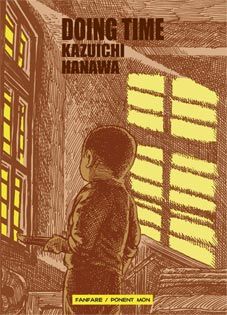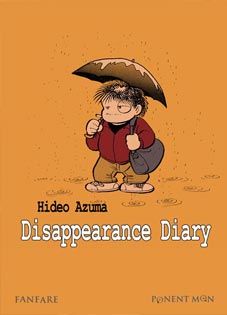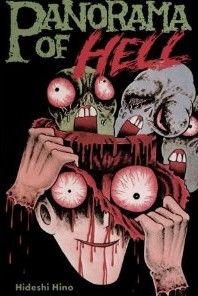Diary and biography comics exist all over the world, and Japan is no exception. The most common form we see for manga in English are the short comics that appear in the margins and afterwords of many romance and action series. But there are real manga biographies, some of which I've already touched on. A Drifting Life and Onward Towards Our Noble Deaths are two of the better, more literary ones the deal with specific subjects, but there are a handful of others available. The three below are all fairly different and very eccentric, and worth a look even for those that aren't normally into autobiographies.
Doing Time - Kazuichi Hanawa (1 volume)
I am actually a raging, crazy fan of the work of Kazuichi Hanawa, but it's hard to come by in English. The best is the short story Mercy Flesh, which you can find in the anthology Comics Underground Japan, but there's also In the Deep Forest in Japan as Viewed by 17 Creators, Six Paths of Wealth in Ax, and this book, which is an encyclopedic account of Hanawa's time in prison for possessing a real gun among his collection of model guns. If you ever wondered what it was like to be in a Japanese prison, this is the book for you, because you will not find more detail anywhere else. Hanawa diagrams everything in and about the prison. Their uniforms. The prison itself. The different rooms, like the cafeteria, bathroom, cells, and workshop. Even the meals and the plates they are served on are extensively diagrammed. There are a lot of different characters, and we also learn a lot about the different personalities, work preferences, and how the group passes the time. Hanawa does offer some insight into himself, but we are only spending about half the time with him. Unfortunately, everything here is fairly emotionally remote, so the different prisoners don't have much to talk about except the prison and the various jobs they do. Food is a big deal, and is discussed extensively. Interestingly, Hanawa doesn't offer any sort of explanation or apology for being in prison, he merely documents prison life obsessively and extensively. Hanawa's art style is detailed, heavy, and lends a creepily realistic touch to his usual folkloric stories, but it's merely utilitarian here. Honestly, this volume leans a bit on the mundane side, but it's still interesting as a diary comic of prison life. It's a shame that the only volume of Hanawa's work in English isn't representative of the rest of his stuff, though. This is currently in print and available.
Disappearance Diary - Hideo Azuma (1 volume)
Many comic artists out there probably know the feeling of wanting to get drunk and wander away from your family and career while under a stressful deadline, living out your days as a homeless person. No? Well, that's what Hideo Azuma did, and this book chronicles the two occasions in which he did so, along with his recovery from alcoholism. Hideo Azuma is somewhat popular in Japan as one of the artists that developed the lolicon genre, and while his usual style bears some resemblance to what manga looks like, he claims this story would be too depressing if drawn realistically, so it's drawn in an extremely minimal, cartoony style. And he's right, it's a somewhat awful story, but he tells it with a fair amount of light-heartedness. He often skips over details that would be too depressing to read, like what happens when he comes back to his wife after running off without a word (he says he doesn't draw it because "there was nothing funny about it"). He also glosses over the causes for his departures, which are basically that he was under a deadline and very drunk and didn't want to draw anymore. But the stories about his vagrant lifestyle are fairly amusing. He talks about everything from gathering cigarette butts out of the gutter to roll new cigarettes to how much weight he gained after he found a convenience store dumpster as a source of food. The second time he leaves is for a much longer period of time, and he actually gets a construction job and living quarters elsewhere. He talks a lot about his interactions with other people too, with fellow vagrants and how normal people and police respond to vagrancy. It's an interesting and surprisingly funny story, given that it could be a real downer. There is also a short chapter about his career between the two stories of disappearance, which helps serve as a reference as to why he ran away. The third chapter about his alcoholism is shorter and way more depressing, though he still uses a light touch while discussing his problems and his trip through the AA program. It's a strangely addictive and uplifting read overall. It is currently in print and available.
Panorama of Hell - Hideshi Hino (1 volume)
This one is unlike the others in that it is actually a work of fiction. Strangely, Hino does include a lot of biographical detail in the life of the protagonist, including the fact his family did have tattoos and gangster ties and the fact his family was forced to flee Manchuria just after he was born. Much of it is completely made up though, as you might gather from the description I'm about to give you. I cheated a little bit here, but I'll use any excuse I can to talk about Panorama of Hell. Hino works primarily in the horror genre, and his stories are usually for children, but this one is not. Panorama of Hell still looks a lot like his work for children, and is all the more chilling because of it. The main character is simply an artist, and he directly addresses you as he tells you about his work. He is a Hell painter, and claims that blood is his favorite color. He reveals where he cuts himself to get blood for each of his canvases (less creepy than it sounds since Hino's style lends itself to cartoony, childlike illustration, but still plenty creepy), and goes on at length about how wonderful the smell and color of blood is. Each chapter starts with him showing you one of his canvases, the subject of which is somehow connected to his life in Hell. There's a guillotine in his neighborhood that works all night, and a factory that processes the bodies and heads behind his house. After neighborhood locations, each segment is then about the Artist's family, including his children Krazy Boy and Krazy Girl, whose hobbies include drawing rotting animals and collecting pieces of offal they find lying around, and his wife, who works at a bar that serves the reanimated corpses from the local factories. He then goes on to talk about the life of his grandfather, father, mother, brother, and eventually himself, and again, this is where it overlaps with Hino's life. The story details become somewhat more realistic and rooted in historical fact as we find out his life was touched dramatically by the events of WWII. The book ends with the complete mental breakdown of the Artist, in a handful of scenes that are so surreal and jarring that I'll probably never forget them. Now, I usually dislike stories that are ghoulish and over-the-top simply for the sake of it, but Panorama of Hell is different. The direct address goes far to grounding all of this in the Artist's reality, so none of it appears for comedic effect, and that makes it all the more creepy. Again, Hino's style is primarily a result of drawing children's horror comics, so his squat, bug-eyed characters and cartoony animal parts aren't all that scary. Most of the time. He will sometimes use a lot of detail, and that makes things much worse than you would expect. Some pages are difficult to look at, which is a feat considering there's nothing too terribly graphic in here. Hino also drew this with the intention of turning it in as his last work ever, so he intended it as a kind of high note to his career. What I'm trying to say is that this is the best horror comic I've ever read, and I read a lot of horror comics. I read this almost ten years ago, and to this day it still gives me the willies. The bad news is that this book came out in 1989 from a small publisher, and is long out of print. Used copies rarely dip below $40. If you ever see it, grab it.




